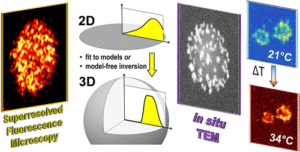Researchers at RWTH Aachen University, DWI − Leibniz-Institute for Interactive Materials and theHelmholtz-Zentrum Berlin für Materialien und Energie have used Hummingbird Scientific’s liquid-heating TEM platform to visualize compartementalization in adaptive microgels. They recently presented their findings in Nano-letters.

Copyright © 2016 American Chemical Society
Compartmentalization in soft materials is important for segregating and coordinating chemical reactions as well as sequestering (re)active components. The authors show the direct visualization of different compartments within adaptive microgels using a combination of in-situ electron and fluorescence microscopy. By acquiring an unprecedented levels of structural details they address the challenge of reconstructing 3D information from 2D projections for nonuniform soft matter as opposed to monodisperse proteins. They also show the thermally induced shrinkage of responsive core–shell microgels in water. Applying the methods used in this work more broadly open doors for in-situ studies of soft matter systems and their application as smart materials.
3D Structures of Responsive Nanocompartmentalized Microgels
View All News

